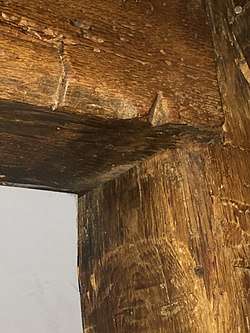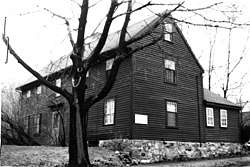Jonathan Green House
The Jonathan Green House is a historic Colonial American house, built c. 1700[1]–1720.[2] It is located at 63 Perkins Street, Stoneham, Massachusetts. It was listed on the National Register of Historic Places in 1984.[3] It is one of the oldest structures in Stoneham, and one of only two structures in Stoneham preserving a nearly intact early eighteenth century form.

Jonathan Green House | |
 | |
  | |
| Location | 63 Perkins St., Stoneham, Massachusetts |
|---|---|
| Coordinates | 42°28′1″N 71°4′50″W |
| Built | 1720 |
| Architectural style | Georgian, Colonial Vernacular |
| MPS | Stoneham MRA |
| NRHP reference No. | 84002627 |
| Added to NRHP | April 13, 1984 |

Construction history
When originally constructed, the house was a single cell: a single room of two structural bays, plus an end chimney bay with the primary entrance and staircase located in front of the chimney stack. The area to the east of the chimney was used as a stable.[4] Currently, the main block is two and a half stories high, five bays wide, and one room deep, with a central chimney. The centered entrance was framed by simple pilasters and topped by a modest entablature (no longer extant). Single story ells project from the northeast and northwest corners.
Later history
Home to several generations of the Green family throughout the 18th and 19th centuries, its most notable resident was Capt. Jonathan Green, a prominent citizen of Stoneham, who served as town clerk and treasurer, and represented the town at a Constitutional Convention[5] to consider a constitution reported in the summer of 1787 by the Constitutional Convention in Philadelphia.[6]
In 1825 and 1826 the house served as the Stoneham school house.[7] In 1853 following the annexation of land in Stoneham to become the Melrose Highlands, this house and several others near the town line were granted the privilege of sending children occupants to school within the town of Melrose.[8]
See also
- Millard-Souther-Green House, c. 1700
- National Register of Historic Places listings in Stoneham, Massachusetts
- National Register of Historic Places listings in Middlesex County, Massachusetts
References
- Dean. Brief History. p. 12.
- "National Park Service".
- "National Register Information System". National Register of Historic Places. National Park Service. April 15, 2008.
- Dean. Stoneham. p. 341.
- Elliot. Debates. p. 179.
- "NRHP nomination for Jonathan Green House". Commonwealth of Massachusetts. Retrieved 2014-01-25.
- Stevens. History of Stoneham. p. 323.
- "1853 Chap. 0045. An Act To Set Off A Part Of The Town Of Stoneham And Annex The Same To The Town Of Melrose". Commonwealth of Massachusetts. hdl:2452/95992. Cite journal requires
|journal=(help)
Bibliography
- Dean, Silas (1870). A Brief History of the Town of Stoneham, Massachusetts. Stoneham, Mass.: Sentinel Press. p. 12.
Jonathan Green stoneham.
- Dean, Silas (1880). "Stoneham". In Drake, Samuel Adams (ed.). History of Middlesex County, Massachusetts. Boston: Estes and Lauriat. p. 341.
341.
- Elliot, Jonathan (1891). The Debates in the Several State Conventions on the Adoption of the Federal Constitution, as Recommended by the General Convention at Philadelphia, in 1787. 2. Philadelphia: Lippincott.
- Stevens, William Burnham (1891). History of Stoneham, Massachusetts. Stoneham, Mass.: F.L. & W. E. Whittier.
